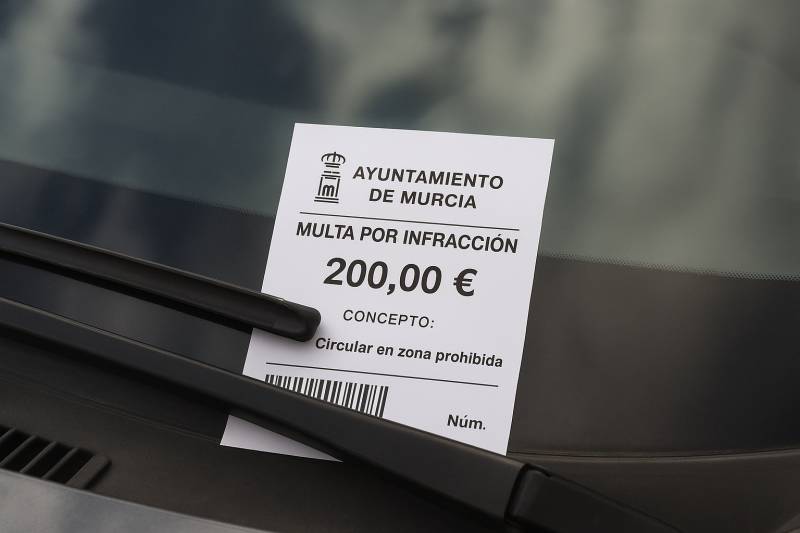- Region
- Águilas
- Alhama de Murcia
- Jumilla
- Lorca
- Los Alcázares
- Mazarrón
- San Javier
-
ALL AREAS & TOWNS
- AREAS
- SOUTH WEST
- MAR MENOR
- MURCIA CITY & CENTRAL
- NORTH & NORTH WEST
- TOWNS
- Abanilla
- Abarán
- Aguilas
- Alamillo
- Alcantarilla
- Aledo
- Alhama de Murcia
- Archena
- Balsicas
- Blanca
- Bolnuevo
- Bullas
- Cañadas del Romero
- Cabo de Palos
- Calasparra
- Camping Bolnuevo
- Campo De Ricote
- Camposol
- Canada De La Lena
- Caravaca de la Cruz
- Cartagena
- Cehegin
- Ceuti
- Cieza
- Condado de Alhama
- Corvera
- Costa Cálida
- Cuevas De Almanzora
- Cuevas de Reyllo
- El Carmoli
- El Mojon
- El Molino (Puerto Lumbreras)
- El Pareton / Cantareros
- El Raso
- El Valle Golf Resort
- Fortuna
- Fuente Alamo
- Hacienda del Alamo Golf Resort
- Hacienda Riquelme Golf Resort
- Isla Plana
- Islas Menores & Mar de Cristal
- Jumilla
- La Azohia
- La Charca
- La Manga Club
- La Manga del Mar Menor
- La Pinilla
- La Puebla
- La Torre
- La Torre Golf Resort
- La Unión
- Las Palas
- Las Ramblas
- Las Ramblas Golf
- Las Torres de Cotillas
- Leiva
- Librilla
- Lo Pagan
- Lo Santiago
- Lorca
- Lorquí
- Los Alcázares
- Los Balcones
- Los Belones
- Los Canovas
- Los Nietos
- Los Perez (Tallante)
- Los Urrutias
- Los Ventorrillos
- Mar De Cristal
- Mar Menor
- Mar Menor Golf Resort
- Mazarrón
- Mazarrón Country Club
- Molina de Segura
- Moratalla
- Mula
- Murcia City
- Murcia Property
- Pareton
- Peraleja Golf Resort
- Perin
- Pilar de la Horadada
- Pinar de Campoverde
- Pinoso
- Playa Honda
- Playa Honda / Playa Paraíso
- Pliego
- Portmán
- Pozo Estrecho
- Puerto de Mazarrón
- Puerto Lumbreras
- Puntas De Calnegre
- Region of Murcia
- Ricote
- Roda Golf Resort
- Roldan
- Roldan and Lo Ferro
- San Javier
- San Pedro del Pinatar
- Santiago de la Ribera
- Sierra Espuña
- Sucina
- Tallante
- Terrazas de la Torre Golf Resort
- Torre Pacheco
- Totana
- What's On Weekly Bulletin
- Yecla


- EDITIONS:
 Spanish News Today
Spanish News Today
 Alicante Today
Alicante Today
 Andalucia Today
Andalucia Today
Conjunto Monumental de San Juan de Dios
The Conjunto combines Moorish, baroque and contemporary Murcia
 The Conjunto Monumental of San Juan de Dios represents three distinct elements of Murcia's history; the Moorish occupation, the baroque splendour of the 18th century and the contemporary city.
The Conjunto Monumental of San Juan de Dios represents three distinct elements of Murcia's history; the Moorish occupation, the baroque splendour of the 18th century and the contemporary city.
These three different experiences within one complex combine to present a fascinating snapshot of three distinct episodes in Murcia's history, with the archaeological remains of the Alcázar Mayor of Murcia beneath the church, the church itself with sculptures by baroque master sculptor Francisco Salzillo, and the choir, which holds an exhibition of works by contemporary sculptor González Moreno.
Conjunto Monumental San Juan de Dios
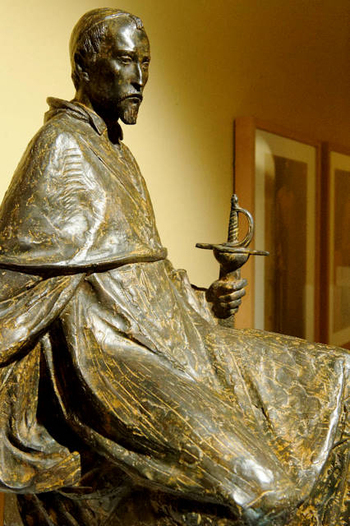 Calle San Juan de Dios
Calle San Juan de Dios
Telephone 968 21 45 41
Click for map Calle San Juan de Dios. (just a few metres from the Cathedral so it is easy to visit both in one morning.)
Opening Hours Conjunto Monumental San Juan de Dios, Murcia.
Tuesday to Saturday 10am to 1.30pm and 5pm to 8pm
Sundays 10am to 1.30pm, Mondays closed
NB During July and August the Conjunto is closed in the evenings.
24th and 31st December 10am to 1.30pm
Entry is free and guided visits (in Spanish) are carried out continuously throughout the opening hours. For English speaking groups, call to book.
The history of this church begins beneath the feet of modern-day visitors, in the era of Moorish occupation when the City of Murcia, Mur-siya, was born.
CITY WALL, ORATORY AND PANTHEON OF THE MOORISH ALCÁZAR
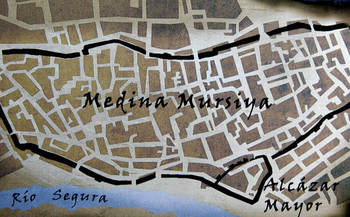 In brief, in the early 8th century what is now the Region of Murcia was occupied by Visigoth tribes, but began to come under attack from invading Arab forces who swept through southern Spain. In 713, this area was surrendered to the invaders in what is known as the "Pact of Tudmir".
In brief, in the early 8th century what is now the Region of Murcia was occupied by Visigoth tribes, but began to come under attack from invading Arab forces who swept through southern Spain. In 713, this area was surrendered to the invaders in what is known as the "Pact of Tudmir".
Although initially the administrative reins of the area were left under the control of a Visigoth "governor", Mur-siya was founded by the Moors on the site of a small Roman settlement called Murtia in 825 AD, growing to become an impressive walled Arab city with strong fortifications.
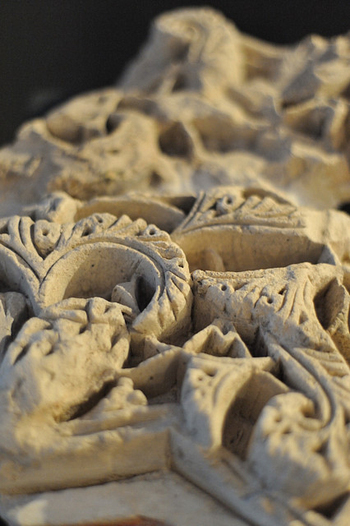 Visitors descend beneath the church to the archaeological remains of the old Moorish Alcázar,(fortress or castle), where the 30-metre-long stretch of wall once formed part of the defensive fortifications of the city's Alcázar Mayor.
Visitors descend beneath the church to the archaeological remains of the old Moorish Alcázar,(fortress or castle), where the 30-metre-long stretch of wall once formed part of the defensive fortifications of the city's Alcázar Mayor.
This area contains the interesting remains of an oratory arch (or "mihrab"), complete with its original painting and decoration, as well as a royal pantheon ("rawda"), with nine tombs in the form of mounds. These tombs are thought to belong to the family of the sovereign Ibn Mardanis, known as the "Rey Lobo" (wolf king), who reigned in Murcia from 1147 to 1172 .
There are many legacies from the Arab domination of Murcia throughout this city, the most substantial being the area of San Esteban which is undergoing a process of musealization at the moment and covers an extensive 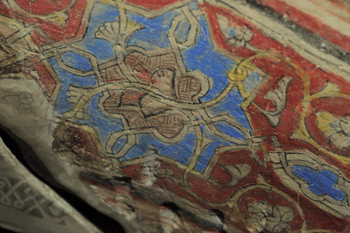 area, as well as other remnants which visitors can discover in the Museums and cultural centres of Murcia.
area, as well as other remnants which visitors can discover in the Museums and cultural centres of Murcia.
The Church of San Juan de Díos
In 1243 Murcia became a Christian City, the conquering King Alfonso X, better known as "Alfonso, El Sabio" ordering the conversion of the Mezquita menor of the Alcázar to become the first Christian sanctuary dedicated to the Holy Virgen in 1243. This was named Santa María la Real del Alcázar Viejo. Converting existing structures was a fairly common act at this time, re-using the Moorish structures which already existed until new ones could be built.
In 1266 the Mezquita Mayor was consecrated as the Cathedral, following works adapting the former Moorish structure for Christian purposes. Arab remains can be seen in the Cathedral Museum, lit up beneath the floor of Murcia Cathedral.
In 1278 Alfonso X donated the tower known as the Caramajul to the Knights Templars, giving them the right to construct a church and hospital.
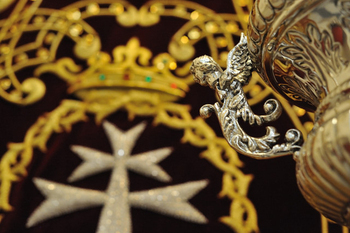 By 1311 the Templars were disbanded and the building reverted to the city administration.
By 1311 the Templars were disbanded and the building reverted to the city administration.
In 1541 the heart of Alfonso X, which had been interred at the feet of the Virgen in his first Christian chapel, was transferred into the new Cathedral by order of Carlos V, where it remains today.
1617. The Order of the the Brothers Hospitaller of San Juan de Dios take charge of the hospital, transferring their operations from the convento del Buen Suceso. The hospital remains attached to the church until it´s demolition in the 20th century.
1690. Canonisation of San Juan de Díos. From this date on the church became known as la Iglesía de Santa María de Gracia y San Juan de Díos.
1764 The current oval-shaped building we see today was designed by Martín Solera, with the demolition of the former construction initiated in 1764 . Financing to build this splendid new church, came from José Marín y Lamas, senior prebend of the Cathedral of Murcia, who had visited Rome in 1714 and was most taken by the great works he saw, particularly those by the incomparable Italian master, Bernini.
1782 The church is completed, in the finest "Bernini" baroque style.
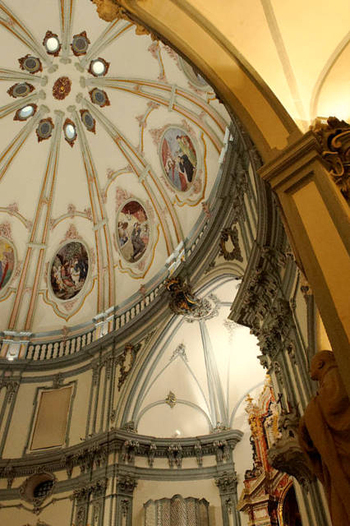 This oval-shaped temple measures 16 metres by 11 metres, and is surrounded by six quadrangular chapels which are connected among each other. The area housing the high altar is semi-circular and is placed opposite the main door, marking the principal axis of the church.
This oval-shaped temple measures 16 metres by 11 metres, and is surrounded by six quadrangular chapels which are connected among each other. The area housing the high altar is semi-circular and is placed opposite the main door, marking the principal axis of the church.
The curved ceiling is decorated with scenes from the life of San Juan de Dios, painted by Agustín Navarro. The altarpieces of imitation architecture are the work of the Italian painter Pablo Síxtori.
Especially noteworthy are the beautiful figures by Francisco Salzillo, representing San Rafael, San José with the Baby Jesus and San Joaquín with the young Mary. Two of the city's brotherhoods are based here: the Santísimo Cristo Yacente and the Virgen de la Luz en su Soledad.
1835. The brotherhoods were expelled from the hospital and it passes to the council.
1953 The hospital transfered to a new location and the building was demolished (except for the chapel of San Juan de Díos.
1999 The Church was declared in danger of collpase and an intense period of restoration began to return it to its current splendour.
Important works of art in the church of San Juan de Díos:
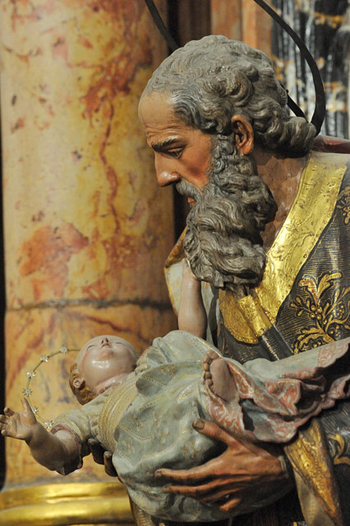 Capillas (chapels) from right to left
Capillas (chapels) from right to left
1. Capilla de la Soledad y Cristo Yacente
Ntra. Sra. de la Luz en su Soledad: Sculpture in polychrome wood (head and hands) . School of Pedro de Mena. Granada, 17th century. Example in Murcia of passion sculpture of the Holy Virgin, prior to Salzillo. One of the figures of the Cofradía del Cristo Yacente, procession on Easter Saturday.
Santísimo Cristo Yacente: Sculpture in polychrome wood attributed to Diego de Ayala, 16th century. Mannerist sculpture, featuring expressionist treatment of the marks of the Passion. An early version of the iconographical topic which was to become very popular in the 17th century. The leading figure of the Cofradía del Cristo Yacente, whose procession is on Easter Saturday.
2. Capilla del Cristo de la Salud
Santísimo Cristo de la Salud: Sculpture in polychrome wood measuring about 1.85 metres. Anonymous sculptor in the late 15th or early 16th century, during the reign of the Catholic Monarchs. The highly mystic Cristo de la Salud was the figurehead of a brotherhood dedicated to help the sick in hospital, which now has its procession on the Tuesday of Easter Week.
3. Capilla de San Juan de Dios
San Juan de Dios: Dressed figure, anonymous sculptor in the 17th century. Heavily revised in the 18th century. Presented as patriarch of the Order of Hospitallers, with habit and walking stick.
 4. Capilla de San Rafael
4. Capilla de San Rafael
San Rafael Arcángel: Sculpture in strengthened polychrome wood. By Francisco Salzillo, 18th century. One of the most exquisite pieces from the Murcian Baroque period. The archangel is represented according to the iconography of the Brothers Hospitaller of San Juan de Dios, whom he is said to protect, with the scapula of the orders habit and the fish which cured the blindness of Tobias.
5. Capilla de Ntra. Sra. de la Asunción (Antes de la Coronación)
Virgen del Tránsito (Dormición de la Virgen): Image to be dressed, anonymous sculptor, 17th century. In 1636 Estangueta made the altarpiece showing the Coronación de la Virgen for the church on the condition that space should be left to place the Cuerpo Yacente de la Virgen there. Shows the formal characteristics common to the southern Italian school of baroque imagery.
Asunción de María: Sculpture in gold-leafed and polychrome wood. Anonymous sculptor, mid-16th century. Iconogrpahy of the time identified with the Inmaculada Concepción. Placed under a triumphal arch sculpted with gold-leaf in the 17th century.
Virgen de las Angustias: Bears all the hallmarks of the style of Salzillo, inspired by the figure in the parish of San Bartolomé (Murcia) which is believed to have been produced in Salzillos workshop, probably by Roque López or Marcos Laborda. Made after Salzillos death, probably at the end of the 18th century or beginning of the 19th.
High Altar
Escultura de Santa María la Real de Gracia y Buen Suceso: 16th century polychomre sculpture turned into an image to be dressed during the baroque. The saint to whom the church has been dedicated since it was founded by Alfonso X on the same site as the current church, she was also the patron saint of the old hospital which bore her name.
Alfonso X founded the first church after the Reconquista on the site of the old Moorish Alcázar, and dedicated it to Santa María la Real. The cathedral chapters patron saint is the Virgen de Gracia, and her name was added to that of the hospital church. When the Brothers of san juan de Díos took over the church and the hospital of San Juan de Dios, they also added the title of Buen Suceso, which was the name of the monastery from which the monks had come.
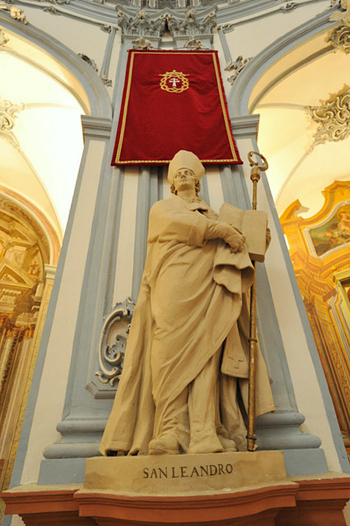 Ángeles Ceriferarios: Sculptures in strengthened polychrome wood and silver, the work of Francisco Salzillo, 18th century. Named thus because of the wax candlesticks they hold, symbolic of their eternal custody of the holy sacraments.
Ángeles Ceriferarios: Sculptures in strengthened polychrome wood and silver, the work of Francisco Salzillo, 18th century. Named thus because of the wax candlesticks they hold, symbolic of their eternal custody of the holy sacraments.
San Joaquín y la Virgen Niña: Sculpture in strengthened polychrome wood. By Francisco Salzillo, 18th century. 1.32 metres high. The sculptor uses his favourite iconography for this saint, with the Virgin Mary held in his arms.
San José con el Niño: Sculpture in strengthened polychrome wood. By Francisco Salzillo, 18th century. 1.30 metres high. One of Salzillos many versions of this figure, similar to the San Joaquín figure: together they form a pair.
The artistic and cultural heritage of San Juan de Dios also includes two polychrome wood figures. One represents Cristo Resucitado, and is sculpted in strengthened polychrome wood. The sculptor is thought to be Cristóbal de Salazar, and the figure dates from the late 16th or early 17th century. It forms a pair with the Ecce Homo, and in the old church they were both on the high altar. They are altarpieces, and are not sculpted at the back.
The plaster sculptures next to the buttresses inside the church are intended to imitate stone, and represent the four saints of Cartagena: San Leandro, San Isidoro, Santa Florentina and San Fulgencio (a clear allusion to the pillars of the local church), as well as San Bernardo and San José. They are generally held to be the work of José Martínez Reina, who was born in Caravaca in 1748.
The decorated circular windows on the ceiling show scenes from the life of San Juan de Dios as well as some of his miracles. Some attribute them to the painter Agustín Navarro, but it is also possible that they are the work of Joaquín Campos. These frescoes were recently repainted, following the original design and colours.
The third element: contemporary art
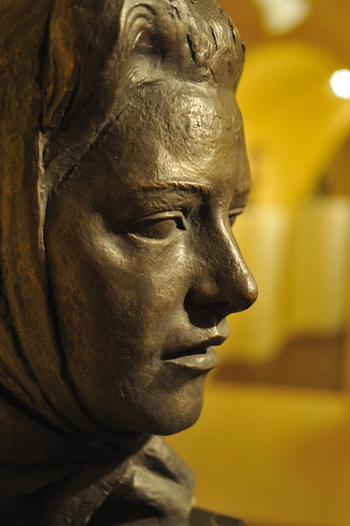 The choir and ambulatory of the church have now been converted into a new space for exhibitions, and there is a permanent display of the legacy bequeathed by Juan González Moreno to the Region of Murcia in 1996. The exhibits include sculptures of various sizes and types as well as drawings, together with some of the tools and equipment used by the Murciano artist, including his workbench, working models in clay and moulds.
The choir and ambulatory of the church have now been converted into a new space for exhibitions, and there is a permanent display of the legacy bequeathed by Juan González Moreno to the Region of Murcia in 1996. The exhibits include sculptures of various sizes and types as well as drawings, together with some of the tools and equipment used by the Murciano artist, including his workbench, working models in clay and moulds.
Access to the choir is via the external space of the Tax office, the Hacienda, a high-tech modern building which now occupies the original location of the hospital, which was joined to the church. Visiting the third element of this site, the visitor leaves the baroque interior of the current church to access the choir of the church vía an external walkway and staircase, part of the original accesses to the church from the former hospital.
Juan González Moreno was an important 20th century sculptor who dedicated much of his output to replacing sculptures which were destroyed during the terrible years of Civil war which wracked Spain and decimated much of the countries´ religious cultural heritage.
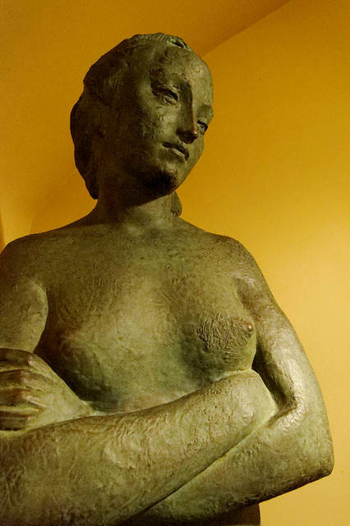 In this region alone, hundreds of sculptures were burnt, along with the churches which held them, and Moreno was commissioned to make many of the pieces which now form the core of the Semana Santa processions and religious acts within the Region of Murcia.
In this region alone, hundreds of sculptures were burnt, along with the churches which held them, and Moreno was commissioned to make many of the pieces which now form the core of the Semana Santa processions and religious acts within the Region of Murcia.
He also created many important pieces which can be seen throughout the City, including the statue of Cardenal Belluga, after whom the Plaza in front of the Cathedral is named.
This little exhibition holds some beautiful sculptures and is a real surprise when visiting the complex.












